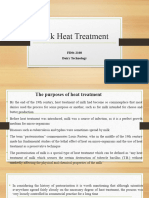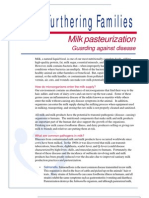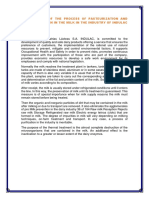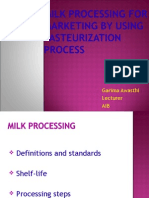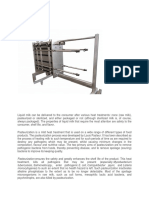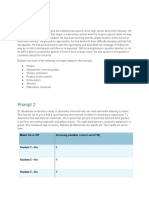A Mini Review On Technique of Milk Pasteurization: Simran Watts
Uploaded by
Azzhna pA Mini Review On Technique of Milk Pasteurization: Simran Watts
Uploaded by
Azzhna pJournal of Pharmacognosy and Phytochemistry 2016; 5(5): 99-101
E-ISSN: 2278-4136
P-ISSN: 2349-8234
JPP 2016; 5(5): 99-101 A mini review on technique of milk pasteurization
Received: 15-07-2016
Accepted: 16-08-016
Simran Watts
Simran Watts
Department of Biotechnology, Abstract
Mahatma Jyoti Rao Phoole
The process of pasteurization was debated in the House of Commons and the suggestion made that no
University, Jaipur, India.
raw milk should be sold for human consumption. This would mean installation of expensive machinery
by every supplier, and if it should become compulsory there is little doubt that many small firms would
shut down and the business pass in the hands of a few big dealers.
If we are to be compelled to drink pasteurized milk, we should at least understand what pasteurization
means. It set out to accomplish two things: Destruction of certain disease carrying germs and the
prevention of souring milk. These results are obtained by keeping the milk at a temperature of 145
degrees to 150 degrees F. for half an hour, at least, and then reducing the temperature to not more than 55
degrees F. Pasteurization can be done as a batch or a continuous process. A vat pasteurizer consists of a
temperature controlled, closed vat. Milk bacteria like acid producers, Gas producers, ropy or stingy
fermentation, proteolytic and lipolytic bacteria which are killed by process of pasteurization.
Keywords: Milk, pasteurization. pasteurization temperature, Bacillus, Coliforms
Introduction
A process named after scientist Louis Pasteur which uses the application of heat to destroy
human pathogens in foods. For the dairy industry, the terms "pasteurization", "pasteurized"
and similar terms shall mean the process of heating every particle of milk or milk product, in
properly designed and operated equipment, at a specific temperature and held continuously at
or above that temperature for at least the corresponding specified time [1].
Pasteurization is the process of heating every particle of milk or milk product. Pasteurization
involves heating food to a temperature that kills disease-causing microorganisms and
substantially reduces the levels of spoilage organisms. Pasteurization or pasteurisation kills
microbes (mainly bacteria) in food and drink, such as milk, juice, canned food, and others. It
was invented by French scientist Louis Pasteur during the nineteenth century. Unlike
sterilization, pasteurization is not intended to kill all microorganisms in the food. Instead, it
aims to reduce the number of viable pathogens so they are unlikely to cause disease (assuming
the pasteurized product is stored as indicated and is consumed before its expiration date).
Commercial-scale sterilization of food is not common because it adversely affects the taste and
quality of the product.
Significant events in the development of Milk Pasteurization
1765 the Italian naturalist, Spallanzani, noted that boiling preserves meat extracts.
1782 the Swedish chemist, Scheele, preserved vinegar by boiling
1810 Appert used heat treatment to preserve foods (closed container).
1861 the "germ theory" was developed
1864 Pasteur reported that heat application to wine and beer prevents acid, bitter and ropy
defects in wine. (This process was termed "pasteurization".)
1867 Pasteur applies heat to milk and reports the process postponed milk souring.
1886 the heating of milk (boiled in a bottle) for infant feeding reduced illness and saved lives
by eliminating pathogens was advocated by Soxhlet (Germany), Jacobi (U.S.).
1893 Straus set up facility to pasteurize milk for infants. The first medical commission was
formed to oversee the production of “certified milk”.
1920's “Endicott studies” occurred in Endicott, NY by dr’s north and pack developing
Correspondence temperature destruction curves relative to mycobacterium and tuberculosis
Simran Watts 1924 the Usphs created "the office of milk investigations" under the strong leadership of Leslie
Department of Biotechnology, Carl frank.
Mahatma Jyoti Rao Phoole 1924 the state of Alabama worked closely with the Usphs to develop the first federal milk
University, Jaipur, India.
ordinance patterned after "the Alabama standard milk grading ordinance."
~ 99 ~
Journal of Pharmacognosy and Phytochemistry
1941 Pyrex heat-resistant glass piping used in dairy industry known as the “dairy initiatives”. Emphasis placed on in-depth
as a means of conserving critical materials during wartime. FDA and state ratings involving down- time equipment
1952 several states met in St. Louis to discuss the problems of inspections, product sampling, and tracing product flows to
reciprocity for shipping milk across state lines. This was the evaluate possible cross connections.
first national conference on interstate milk shipments. Also 1986 Listeria outbreaks in California fuels further
much recognition to Dr. C.A. Abele and Dr. Everett investigations on post pasteurization contamination problems
wallenfeldt for their early pioneering efforts in the in cheese and milk plants. Computer controls accepted for
development of the grade a milk program. milk pasteurization systems
1953 the first 3-a standard for CIP cleaning was published. 1994 salmonella outbreak traced to ice cream. Probable
1955 the first automated CIP system installed in an Ohio milk etiology was hauling of raw liquid eggs in milk tanker which
plant. was used to subsequently haul pasteurized mix. Freezing and
1956 minimum temperature for vat pasteurization was raised packaging was done without re-pasteurizing the mix. Large
from 142 of to 145 of based on heat resistance of coxiella numbers of culture confirmed cases.
burnetii. Based on university of california-davis studies in late 1994 contaminated water in a plant was suspected cause of
1940's 1966 FDA memorandum accepts dual stem (CIP) flow packaged milk transmitting E. coli to consumers in Montana.
diversion device to be used in htst systems. Failure of well disinfectant led to subsequent contamination
1978 first u.s. uht “sterile” milk system commissioned in of pasteurized milk storage tank culture confirmed cases plant
Georgia. closed [2]
1979 magnetic flow meter systems found acceptable for use
as replacement for conventional timing pumps. Types of pasteurization
1985 major salmonellosis outbreak in Chicago spawned
increased emphasis on milk processing sanitation, became
Table 1: Types of milk pasteurization Process of pasteurization of milk [4]
There are four common types of milk pasteurization that vary • Vat Pasteurization
with temperature and time the milk is held at that temperature • High Temperature/Short Time (HTST)
[5]
. • Ultra-pasteurization (UP)
• Ultra-High-Temperature (UHT)
Fig 1: Milk Pasteurization Technique [6]
~ 100 ~
Journal of Pharmacognosy and Phytochemistry
Micro-organisms killed by pasteurization
Acid producers- Streptococci, Lactobacilli, Microbacteria,
Coliforms, Micrococci Gas producers- Coliforms, Clostridium
butyricum, Torula cremoris Ropy or stringy fermentation-
Alcaligenes viscolactis, Enterobacter aerogenes Proteolytic
organisms- Bacillus spp., Pseudomonas spp., Proteus spp.,
Streptococcus liquefaciens Lipolytic organisms-
Pseudomonas fluorescens, Achromobactor lipolyticum,
Candida lipolytica, Penicillium spp [7]
Conclusion
Pasteurization certainly has its place. But it's widespread use
to process most of the foods we consume, simply to improve
the bottom line of large corporations (by allowing for long-
term warehousing and long-distance shipping of foods, and
skimping of proper cleanliness practices), is not only not
necessary but harmful to our health.
It is undoubtedly beneficial to destroy dangerous germs, but
pasteurization does more than this it kills off harmless and
useful germs alike, and by subjecting the milk to high
temperatures, destroys some nutritious constituents.
References
1. Microbiology Press cott, fifth edition.
2. Lance Day, Ian McNeil. Biographical Dictionary of the
History of Technology. Routledge. ISBN 0415193990. 7.
Gordon L. 1996.
3. Food safety of raw milk. Foodsmart. Govt. nz. Retrieved
20140319.
4. Wilson GS. The Pasteurization of Milk, British Medical
Journal. 1943; 1(4286):261. doi:10.1136/bmj.1.4286.261,
PMC 2282302, PMID 20784713
5. Wikipedia, free encyclopedia.pdf.
6. www.realmilk.com/
7. Oliver SP, Jayarao BM, Almedia RA. Food borne
pathogens in milk and the dairy environment food safety
and public health implications. Food borne Pathogens and
Diseases. 2005; 2:115-1129. [DOI via Crossref]
[Pubmed].
~ 101 ~
You might also like
- Wilbey2014.pdf Tratamiento Térmico de Alimentos, Principios de La PasteruizaciónNo ratings yetWilbey2014.pdf Tratamiento Térmico de Alimentos, Principios de La Pasteruización6 pages
- An Energy Efficient Design For A Mini Milk Pasteurization PlantNo ratings yetAn Energy Efficient Design For A Mini Milk Pasteurization Plant6 pages
- Raw Milk Use and Safety Fact Sheet Science ModuleNo ratings yetRaw Milk Use and Safety Fact Sheet Science Module10 pages
- Milk Pasteurization and Equipment: April 2019No ratings yetMilk Pasteurization and Equipment: April 201931 pages
- Pasturization, Sterilizationo and FermentationNo ratings yetPasturization, Sterilizationo and Fermentation36 pages
- 3.FinalRecentTechnologiesinDairysci Finalbook 17 5 20192 67 94No ratings yet3.FinalRecentTechnologiesinDairysci Finalbook 17 5 20192 67 9429 pages
- Pasteurisation of Foods Products: by Ms. Anita Trivedi Assistant Professor, UCBMSHNo ratings yetPasteurisation of Foods Products: by Ms. Anita Trivedi Assistant Professor, UCBMSH10 pages
- Pasteurization Good or Bad.: Submitted To: Submitted byNo ratings yetPasteurization Good or Bad.: Submitted To: Submitted by10 pages
- Contamination, Preservation and Spoilage of Milk andNo ratings yetContamination, Preservation and Spoilage of Milk and16 pages
- 2 IC the Black Box a First Look Inside a Dairy PlantNo ratings yet2 IC the Black Box a First Look Inside a Dairy Plant61 pages
- University of Engineering and Technology Lahore (KSK Campus)No ratings yetUniversity of Engineering and Technology Lahore (KSK Campus)9 pages
- Food Preservation - Pasteurization 13.02.17No ratings yetFood Preservation - Pasteurization 13.02.1713 pages
- The Bacillus of Long Life a manual of the preparation and souring of milk for dietary purposes, together with and historical account of the use of fermenteFrom EverandThe Bacillus of Long Life a manual of the preparation and souring of milk for dietary purposes, together with and historical account of the use of fermenteNo ratings yet
- Exploring-the-Lived-Experiences-of-College-Working-Students-at-Holy-Infant-College-of-Tacloban-City-Inc (1) (1) (1)No ratings yetExploring-the-Lived-Experiences-of-College-Working-Students-at-Holy-Infant-College-of-Tacloban-City-Inc (1) (1) (1)30 pages
- Masinde Muliro University of Science and TechnologyNo ratings yetMasinde Muliro University of Science and Technology4 pages
- American Heart Association (AHA) CPR Changes: New Guideline Old Guideline Rational For ChangeNo ratings yetAmerican Heart Association (AHA) CPR Changes: New Guideline Old Guideline Rational For Change3 pages
- The Mandible An Atlas of Osteological and Radiological AnatomyNo ratings yetThe Mandible An Atlas of Osteological and Radiological Anatomy457 pages
- HST Clinical Microbiology Curriculum 2020 - Printable VersionNo ratings yetHST Clinical Microbiology Curriculum 2020 - Printable Version70 pages
- The Science Behind Actigin®: Associated Effects On The Human Body Based On Research FindingsNo ratings yetThe Science Behind Actigin®: Associated Effects On The Human Body Based On Research Findings3 pages
- Effects of Small Scale Industries Proliferation On The Quality of Water For Domestic Use in Bauchi State, NigeriaNo ratings yetEffects of Small Scale Industries Proliferation On The Quality of Water For Domestic Use in Bauchi State, Nigeria7 pages
- Phobia Relief From Fear to Freedom Building Your Best Series Book 1 1st Edition Kalliope Barlis Barlis downloadNo ratings yetPhobia Relief From Fear to Freedom Building Your Best Series Book 1 1st Edition Kalliope Barlis Barlis download51 pages






